Evaluating Critical Barriers to Utilization of Solid Waste as Building Material (USB) in China: An Integrated DEMATEL Approach
Abstract
1. Introduction
2. Theoretical Foundations and Barrier Identification
2.1. Stakeholder Theory (ST)
2.2. Institutional Theory (INT)
2.3. Resource-Based Theory (RBT)
2.4. Sustainability Science (SS)
2.5. Transaction Costs Theory (TCT)
2.6. Theory of Planned Behavior (TPB)
2.7. Social Network Theory (SNT)
| Barrier Category | Barriers | Code | Related Theories | References |
|---|---|---|---|---|
| Policy (P) | Incomplete policies and legislation | P1 | INT | [47,48] |
| Poor supervision and regulation of solid waste | P2 | TPB, INT | [49,50] | |
| Unclear responsibility subject | P3 | ST | [51,52] | |
| Insufficient publicity and education by relevant authorities | P4 | TPB, RBT | [29,53] | |
| Lack of demonstration projects and practical experience for replication | P5 | RBT, INT | [34,53] | |
| Economy (E) | Insufficient financial subsidies and incentives | E1 | TCT, RBT | [29,31] |
| Insufficient private capital investment by enterprises | E2 | RBT | [29,52] | |
| High cost involved in waste disposal and recycling | E3 | TCT | [29,54] | |
| Extra cost for transportation and storage sites of solid waste | E4 | RBT, TCT | [55,56] | |
| High price and low profitability of green building materials | E5 | SS, TCT | [57] | |
| Cost competition between informal and formal recycling enterprises | E6 | ST | [52,56] | |
| Insufficient investment in technology development and innovation | E7 | RBT | [34,52,55] | |
| Inadequate investment in equipment and infrastructure | E8 | TCT, RBT | [52,56] | |
| Society (S) | Poor consumer trust in green building materials | S1 | TPB, SS | [52,55] |
| Low media publicity for renewable building materials and demonstration projects | S2 | RBT, TPB | [29,34] | |
| Limited public awareness towards environmental protection and waste recycling | S3 | TPB, SS | [52,55] | |
| Lack of willingness and motivation for participation among stakeholders | S4 | TPB, ST | [29,56] | |
| Insufficient awareness of circular economy and sustainable development in the AEC industry and building material industry | S5 | SS | [29,49] | |
| Technology (T) | Lack of technical and quality standards for USB | T1 | INT | [49,58] |
| Weak application of information technology | T2 | RBT | [55] | |
| Single type and limited application of renewable building material | T3 | RBT, SS | [59] | |
| Unclear composition of solid waste | T4 | RBT | [52,53] | |
| Management (M) | Insufficient training of relevant personnel | M1 | RBT | [52,55] |
| Limited skilled labor | M2 | RBT | [49,52] | |
| Lack of standards and certification for USB enterprises | M3 | INT, TPB | [49,52] | |
| Limited innovation in management models | M4 | INT, TPB | [49,52] | |
| Unclear mechanism towards cleaner production and sustainable development of enterprises | M5 | INT, TPB | [52,53] | |
| Undeveloped markets for comprehensive utilization and recycling of solid waste | M6 | TCT, RBT | [29,34] | |
| Information (I) | Limited knowledge among suppliers and demanders about recycling trading channels and supply chain of solid waste | I1 | TCT, RBT, SNT | [52,59] |
| Lack of communication and cooperation between partners | I2 | SNT | [29,52,55] | |
| Non-transparent and imperfect price information in the recycling market of solid waste | I3 | RBT, TCT | [34,55] | |
| Lack of awareness about market value for USB among stakeholders | I4 | ST, SS, RBT | [34,59] | |
| Lack of prediction of waste generation and recycling capacity | I5 | TCT, RBT | [29,52] |
3. Methodology
3.1. Research Framework
3.2. Analytical Methods and Data
3.2.1. Grounded Theory Method and Data
3.2.2. DEMATEL Method and Data
3.2.3. ISM Method
3.2.4. MICMAC Method
4. Results
4.1. DEMATEL Results
4.2. ISM Results
4.3. MICMAC Results
5. Discussion
6. Conclusions
Author Contributions
Funding
Data Availability Statement
Acknowledgments
Conflicts of Interest
References
- MOEE. Annual Report on China’s Ecological and Environmental Statistics in 2024. 2025. Available online: https://www.mee.gov.cn/hjzl/sthjzk/zghjzkgb/202506/P020250604527010717462.pdf (accessed on 30 June 2025).
- Guo, W.; Xi, B.; Huang, C.; Li, J.; Tang, Z.; Li, W.; Ma, C.; Wu, W. Solid waste management in China: Policy and driving factors in 2004–2019. Resour. Conserv. Recycl. 2021, 173, 105727. [Google Scholar] [CrossRef]
- Technical Center for Solid Waste and Chemical Management of MOEE. National Report on the Release of Information on the Prevention and Control of Solid Waste Pollution to the Environment in 2024. December 2024. Available online: https://www.meescc.cn/zhxx/zxyw/202505/W020250530336582088864.pdf (accessed on 20 September 2025).
- Yu, L.; Zhang, Y.; Liu, H.; Shen, X.; Yang, J. Comprehensive utilization of blast furnace slag, municipal sludge and kaolin clay in building brick manufacture: Crystalline transformation, morphology observation and property assessment. Cem. Concr. Compos. 2024, 145, 105337. [Google Scholar] [CrossRef]
- European Commission. Implementation of the Waste Framework Directive. 2023. Available online: https://environment.ec.europa.eu/topics/waste-and-recycling/implementation-waste-framework-directive_en (accessed on 20 September 2025).
- Ghaffar, S.; Burman, M.; Braimah, N. Pathways to circular construction: An integrated management of construction and demolition waste for resource recovery. J. Clean. Prod. 2020, 244, 118710. [Google Scholar] [CrossRef]
- Chernysh, Y.; Yakhnenko, O.; Chubur, V.; Roubik, H. Phosphogypsum Recycling: A Review of Environmental Issues, Current Trends, and Prospects. Appl. Sci. 2021, 11, 1575. [Google Scholar] [CrossRef]
- Pappu, A.; Saxena, M.; Asolekar, S.R. Solid wastes generation in India and their recycling potential in building materials. Build. Environ. 2007, 42, 2311–2320. [Google Scholar] [CrossRef]
- Abo-El-Enein, S.A.; Hashem, F.S.; Amin, M.S.; Sayed, D.M. Physicochemical characteristics of cementitious building materials derived from industrial solid wastes. Constr. Build. Mater. 2016, 126, 983–990. [Google Scholar] [CrossRef]
- Cintura, E.; Nunes, L.; Esteves, B.; Faria, P. Agro-industrial wastes as building insulation materials: A review and challenges for Euro-Mediterranean countries. Ind. Crop. Prod. 2021, 171, 113833. [Google Scholar] [CrossRef]
- Tripathi, N. Construction: Use waste for building. Nature 2017, 550, 457. [Google Scholar] [CrossRef]
- Ren, C.; Hua, D.; Bai, Y.; Wu, S.; Yao, Y.; Wang, W. Preparation and 3D printing building application of sulfoaluminate cementitious material using industrial solid waste. J. Clean. Prod. 2022, 363, 132597. [Google Scholar] [CrossRef]
- Wu, F.; Liu, X.; Wang, C.; Qu, G.; Liu, L.; Chen, B.; Zhao, C.; Liu, S.; Li, J. New dawn of solid waste resource treatment: Preparation of high-performance building materials from waste-gypsum by mechanical technology. Constr. Build. Mater. 2022, 318, 126204. [Google Scholar] [CrossRef]
- Ji, R.; He, Y.; Zhang, Z.; Liu, L.; Wang, X. Preparation and modeling of energy-saving building materials by using industrial solid waste. Energ. Build. 2015, 97, 6–12. [Google Scholar] [CrossRef]
- Fan, Y.; Li, S.; Li, Y.; Liang, H.; Tang, M.; Huang, K.; Zhu, L. Recycling of municipal solid waste incineration fly ash in foam ceramic materials for exterior building walls. J. Build. Eng. 2021, 44, 103427. [Google Scholar] [CrossRef]
- Gao, W.; Jian, S.; Li, X.; Tan, H.; Li, B.; Lv, Y.; Huang, J. The use of contaminated soil and lithium slag for the production of sustainable lightweight aggregate. J. Clean. Prod. 2022, 348, 131361. [Google Scholar] [CrossRef]
- Soni, A.; Das, P.K.; Hashmi, A.W.; Yusuf, M.; Kamyab, H.; Chelliapan, S. Challenges and opportunities of utilizing municipal solid waste as alternative building materials for sustainable development goals: A review. Sustain. Chem. Pharm. 2022, 27, 100706. [Google Scholar] [CrossRef]
- Lizárraga-Mendiola, L.; López-León, L.D.; Vázquez-Rodríguez, G.A. Municipal Solid Waste as a Substitute for Virgin Materials in the Construction Industry: A Review. Sustainability 2022, 14, 16343. [Google Scholar] [CrossRef]
- Liu, X.; Wu, C.; Lv, W.; Dong, E.; Fu, S.; Feng, Y.; Wang, S.; Chen, Y.; Liu, K.; Yu, R. Stepping into the era of all-solid waste and low carbon: Phosphogypsum and other solid wastes cooperatively construct green buildings. Constr. Build. Mater. 2025, 486, 141926. [Google Scholar] [CrossRef]
- Lu, W.; Bao, Z.; Lee, W.M.; Chi, B.; Wang, J. An analytical framework of “zero waste construction site”: Two case studies of Shenzhen, China. Waste Manag. 2021, 121, 343–353. [Google Scholar] [CrossRef] [PubMed]
- Ma, B.G.; Cai, L.X.; Li, X.G.; Jian, S.W. Utilization of iron tailings as substitute in autoclaved aerated concrete: Physico-mechanical and microstructure of hydration products. J. Clean. Prod. 2016, 127, 162–171. [Google Scholar] [CrossRef]
- Cai, L.; Li, X.; Liu, W.; Ma, B.; Lv, Y. The slurry and physical-mechanical performance of autoclaved aerated concrete with high content solid wastes: Effect of grinding process. Constr. Build. Mater. 2019, 218, 28–39. [Google Scholar] [CrossRef]
- Cai, L.; Tang, T.; Liu, M.; Xie, D. Comparative study of carbide slag autoclaved aerated concrete (AAC) manufactured under thermal oven and microwave pre-curing process: Foaming course, rough body strength and physic-mechanical properties. Constr. Build. Mater. 2020, 236, 117550. [Google Scholar] [CrossRef]
- Chen, L.; Yang, M.; Chen, Z.; Xie, Z.; Huang, L.; Osman, A.; Farghali, M.; Sandanayake, M.; Liu, E.; Ahn, Y.; et al. Conversion of waste into sustainable construction materials: A review of recent developments and prospects. Mater. Today Sustain. 2024, 27, 100930. [Google Scholar] [CrossRef]
- Guo, X.; Zeng, M.; Yu, H.; Lin, F.; Li, J.; Wang, W.; Chen, G. Critical review for the potential analysis of material utilization from inorganic industrial solid waste. J. Clean. Prod. 2024, 459, 142457. [Google Scholar] [CrossRef]
- Vidaurre-Arbizu, M.; Pérez-Bou, S.; Zuazua-Ros, A.; Martín-Gómez, C. From the leather industry to building sector: Exploration of potential applications of discarded solid wastes. J. Clean. Prod. 2021, 291, 125960. [Google Scholar] [CrossRef]
- Smol, M.; Kulczycka, J.; Henclik, A.; Gorazda, K.; Wzorek, Z. The possible use of sewage sludge ash (SSA) in the construction industry as a way towards a circular economy. J. Clean. Prod. 2015, 95, 45–54. [Google Scholar] [CrossRef]
- Leal Filho, W.; Brandli, L.; Moora, H.; Kruopienė, J.; Stenmarck, Å. Benchmarking approaches and methods in the field of urban waste management. J. Clean. Prod. 2016, 112, 4377–4386. [Google Scholar] [CrossRef]
- Yuan, H.; Du, W.; Ma, X.; Liu, J.; Li, L. Critical factors to influence the illegal dumping behavior of construction and demolition waste: An ISM-DEMATEL analysis. Dev. Built Environ. 2023, 14, 100159. [Google Scholar] [CrossRef]
- Yuan, H.; Du, W.; Zuo, J.; Ma, X. Paving a traceable green pathway towards sustainable construction: A fuzzy ISM-DEMATEL analysis of blockchain technology adoption barriers in construction waste management. Ain Shams Eng. J. 2024, 15, 102627. [Google Scholar] [CrossRef]
- Wang, C.; Sun, Y.; Lim, M.K.; Ghadimi, P.; Azadnia, A.H. An analysis of barriers for successful implementation of municipal solid waste management in Beijing: An integrated DEMATEL-MMDE-ISM approach. Ind. Manag. Data Syst. 2023, 123, 931–966. [Google Scholar] [CrossRef]
- dos Muchangos, L.S.; Tokai, A.; Hanashima, A. Analyzing the structure of barriers to municipal solid waste management policy planning in Maputo city, Mozambique. Environ. Dev. 2015, 16, 76–89. [Google Scholar] [CrossRef]
- Sobotka, A.; Linczowski, K.; Radziejowska, A. Substitution of Material Solutions in the Operating Phase of a Building. Appl. Sci. 2021, 11, 2812. [Google Scholar] [CrossRef]
- Sagan, J.; Sobotka, A. Analysis of Factors Affecting the Circularity of Building Materials. Materials 2021, 14, 7296. [Google Scholar] [CrossRef]
- Negash, Y.T.; Hassan, A.M.; Tseng, M.L.; Wu, K.J.; Ali, M.H. Sustainable construction and demolition waste management in Somaliland: Regulatory barriers lead to technical and environmental barriers. J. Clean. Prod. 2021, 297, 126717. [Google Scholar] [CrossRef]
- Mahajan, R.; Lim, W.M.; Sareen, M.; Kumar, S.; Panwar, R. Stakeholder theory. J. Bus. Res. 2023, 166, 114104. [Google Scholar] [CrossRef]
- Magill, M.; Quinzii, M.; Rochet, J.C. A Theory of the Stakeholder Corporation. Econometrica 2015, 83, 1685–1725. [Google Scholar] [CrossRef]
- Wondmagegn, W. Social institutions: A review. Sociol. Int. J. 2024, 8, 198–199. [Google Scholar] [CrossRef]
- Baral, R. Exploring the Prominent Role of Social Institutions in Society. Int. Res. J. MMC 2023, 4, 68–74. [Google Scholar] [CrossRef]
- Grant, R. The Resource-Based Theory of Competitive Advantage: Implications for Strategy Formulation. Calif. Manag. Rev. 1991, 33, 114–135. [Google Scholar] [CrossRef]
- Takeuchi, K. Sustainability science. Cybern. Syst. 2018, 2, 641–642. [Google Scholar] [CrossRef]
- Giddings, B.; Hopwood, B.; O’Brien, G. Environment, economy and society: Fitting them together into sustainable development. Sustain. Dev. 2002, 10, 187–196. [Google Scholar] [CrossRef]
- Rindfleisch, A. Transaction cost theory: Past, present and future. Acute Med. Surg. 2019, 10, 85–97. [Google Scholar] [CrossRef]
- Ajzen, I. The theory of planned behavior. Organ. Behav. Hum. Decis. Process. 1991, 50, 179–211. [Google Scholar] [CrossRef]
- Fuhse, J. Theories of Social Networks. In The Oxford Handbook of Social Networks; Oxford University Press: Oxford, UK, 2020; pp. 34–49. [Google Scholar] [CrossRef]
- Brass, D. New Developments in Social Network Analysis. Annu. Rev. Organ. Psychol. Organ. Behav. 2021, 9, 225–246. [Google Scholar] [CrossRef]
- Xie, D.; Fang, J.; Du, W.; Zhu, J.; Xia, Y.; Yan, H.; Cai, L. Utilization of Solid Waste as Building Materials (USB): Review of Chinese Policies. Sustainability 2025, 17, 1810. [Google Scholar] [CrossRef]
- Tsai, F.M.; Bui, T.D.; Tseng, M.L.; Lim, M.K.; Wu, K.J.; Mashud, A.H.M. Assessing a hierarchical sustainable solid waste management structure with qualitative information: Policy and regulations drive social impacts and stakeholder participation. Resour. Conserv. Recycl. 2021, 168, 105285. [Google Scholar] [CrossRef]
- Jain, S.; Singhal, S.; Jain, N.K.; Bhaskar, K. Construction and demolition waste recycling: Investigating the role of theory of planned behavior, institutional pressures and environmental consciousness. J. Clean. Prod. 2020, 263, 121405. [Google Scholar] [CrossRef]
- Lu, B.; Wang, J. How can residents be motivated to participate in waste recycling? An analysis based on two survey experiments in China. Waste Manag. 2022, 143, 206–214. [Google Scholar] [CrossRef] [PubMed]
- Xie, S.; Gong, Y.; Zhang, A.; Liu, Y.; Li, C. Untangling the critical success factors of the latest compulsory waste sorting initiative in Shanghai: The role of accountability governance. J. Clean. Prod. 2024, 444, 141268. [Google Scholar] [CrossRef]
- Kumar, A.; Dixit, G. Evaluating critical barriers to implementation of WEEE management using DEMATEL approach. Resour. Conserv. Recycl. 2018, 131, 101–121. [Google Scholar] [CrossRef]
- Tseng, M.L.; Bui, T.D.; Lim, M.K. Resource utilization model for sustainable solid waste management in Vietnam: A crisis response hierarchical structure. Resour. Conserv. Recycl. 2021, 171, 105632. [Google Scholar] [CrossRef]
- Bao, Z.; Lu, W.; Chi, B.; Yuan, H.; Hao, J. Procurement innovation for a circular economy of construction and demolition waste: Lessons learnt from Suzhou, China. Waste Manag. 2019, 99, 12–21. [Google Scholar] [CrossRef] [PubMed]
- Kumar, A.; Gaur, D.; Liu, Y.; Sharma, D. Sustainable waste electrical and electronic equipment management guide in emerging economies context: A structural model approach. J. Clean. Prod. 2022, 336, 130391. [Google Scholar] [CrossRef]
- Kong, X.T.; Huang, R.; Kang, K.; Xu, S. Combinatorial Group-Buying double auction for recycled remanufacturing products of construction waste. Transp. Res. Part E Logist. Transp. Rev. 2025, 196, 104030. [Google Scholar] [CrossRef]
- He, M.; Jin, Y.; Zeng, H.; Cao, J. Pricing decisions about waste recycling from the perspective of industrial symbiosis in an industrial park: A game model and its application. J. Clean. Prod. 2020, 251, 119417. [Google Scholar] [CrossRef]
- Bui, T.D.; Tsai, F.M.; Tseng, M.L.; Wu, K.J.; Chiu, A.S. Effective municipal solid waste management capability under uncertainty in Vietnam: Utilizing economic efficiency and technology to foster social mobilization and environmental integrity. J. Clean. Prod. 2020, 259, 120981. [Google Scholar] [CrossRef]
- Cui, Y.; Chang, I.S.; Yang, S.; Yu, X.; Cao, Y.; Wu, J. A novel dynamic business model to quantify the effects of policy intervention on solid waste recycling industry: A case study on phosphogypsum recycling in Yichang, China. J. Clean. Prod. 2022, 355, 131779. [Google Scholar] [CrossRef]
- Anselm, S.; Juliet, C. Basics of qualitative research: Grounded theory procedures and techniques. Mod. Lang. J. 2006, 77, 235–236. [Google Scholar] [CrossRef]
- Devaki, H.; Shanmugapriya, S. Investigating barriers to sustainable management of construction and demolition waste: The case of India. J. Mater. Cycles Waste Manag. 2023, 25, 1594–1607. [Google Scholar] [CrossRef]
- Wei, Y.; Zhang, L.; Sang, P. Exploring the restrictive factors for the development of the construction waste recycling industry in a second-tier Chinese city: A case study from Jinan. Environ. Sci. Pollut. Res. 2023, 30, 46394–46413. [Google Scholar] [CrossRef]
- Trivedi, A.; Jakhar, S.K.; Sinha, D. Analyzing barriers to inland waterways as a sustainable transportation mode in India: A DEMATEL-ISM based approach. J. Clean. Prod. 2021, 295, 126301. [Google Scholar] [CrossRef]
- Asadi, S.; Nilashi, M.; Iranmanesh, M.; Ghobakhloo, M.; Samad, S.; Alghamdi, A.; Almulihi, A.; Mohd, S. Drivers and barriers of electric vehicle usage in Malaysia: A DEMATEL approach. Resour. Conserv. Recycl. 2022, 177, 105965. [Google Scholar] [CrossRef]
- Rossi, D.; Lermen, F.H.; Fernandes, S.d.C.; Echeveste, M.E.S. Exploring business model strategies to achieve a circular bioeconomy from a waste valorization perspective. Environ. Dev. Sustain. 2025, 27, 12281–12304. [Google Scholar] [CrossRef]
- Bilal, M.; Khan, K.I.A.; Thaheem, M.J.; Nasir, A.R. Current state and barriers to the circular economy in the building sector: Towards a mitigation framework. J. Clean. Prod. 2020, 276, 123250. [Google Scholar] [CrossRef]
- Campbell-Johnston, K.; ten Cate, J.; Elfering-Petrovic, M.; Gupta, J. City level circular transitions: Barriers and limits in Amsterdam, Utrecht and The Hague. J. Clean. Prod. 2019, 235, 1232–1239. [Google Scholar] [CrossRef]
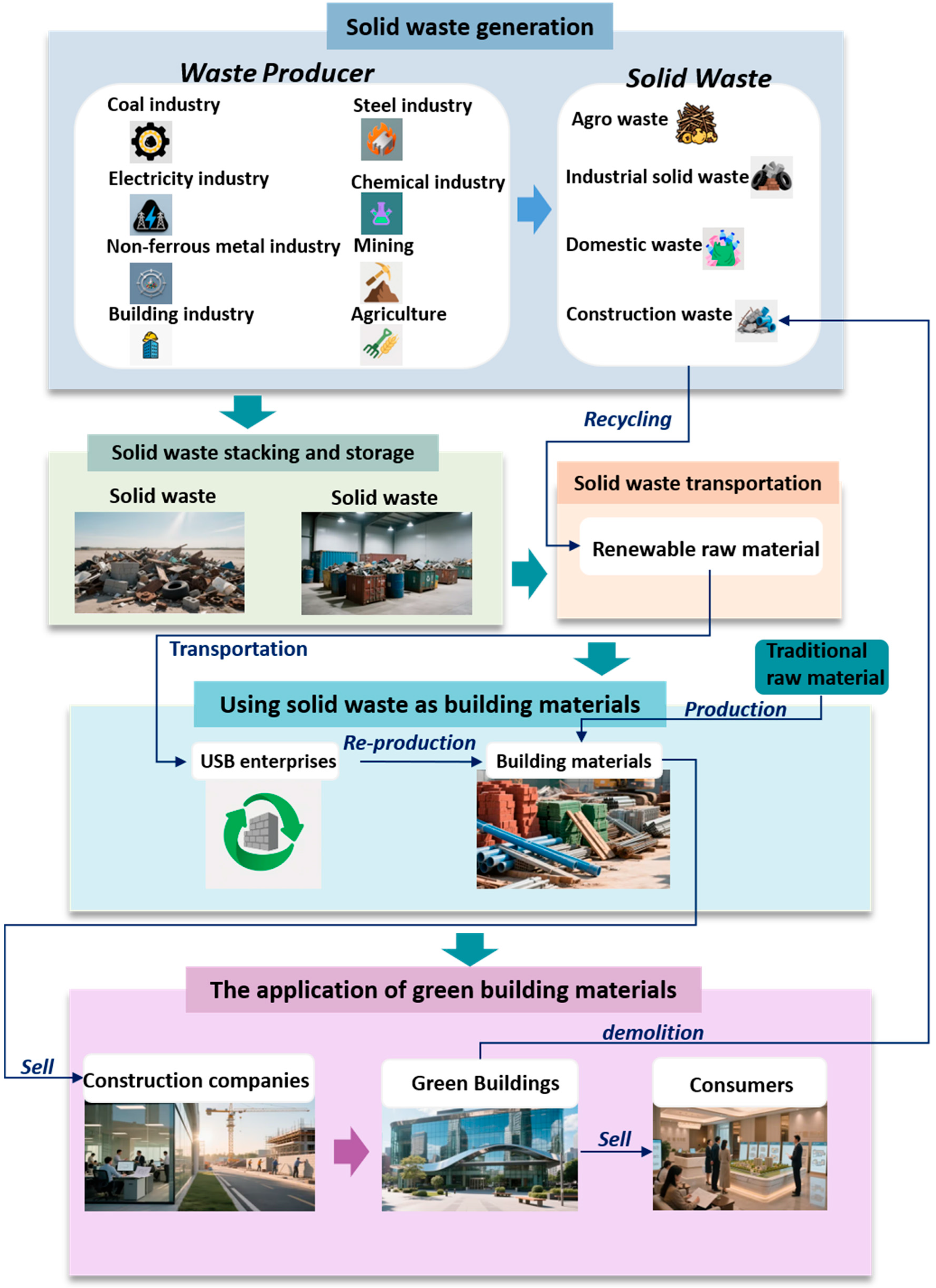
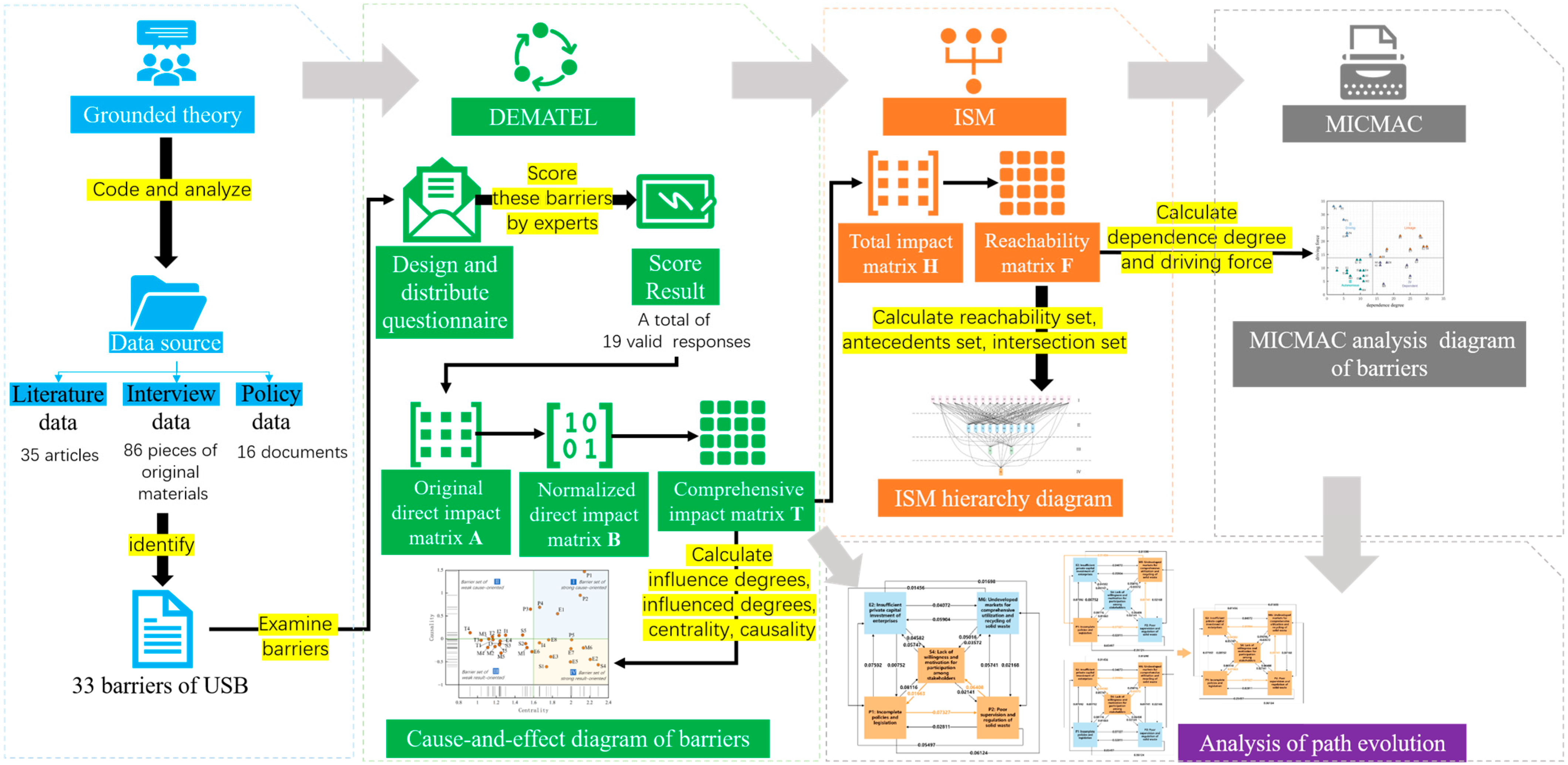
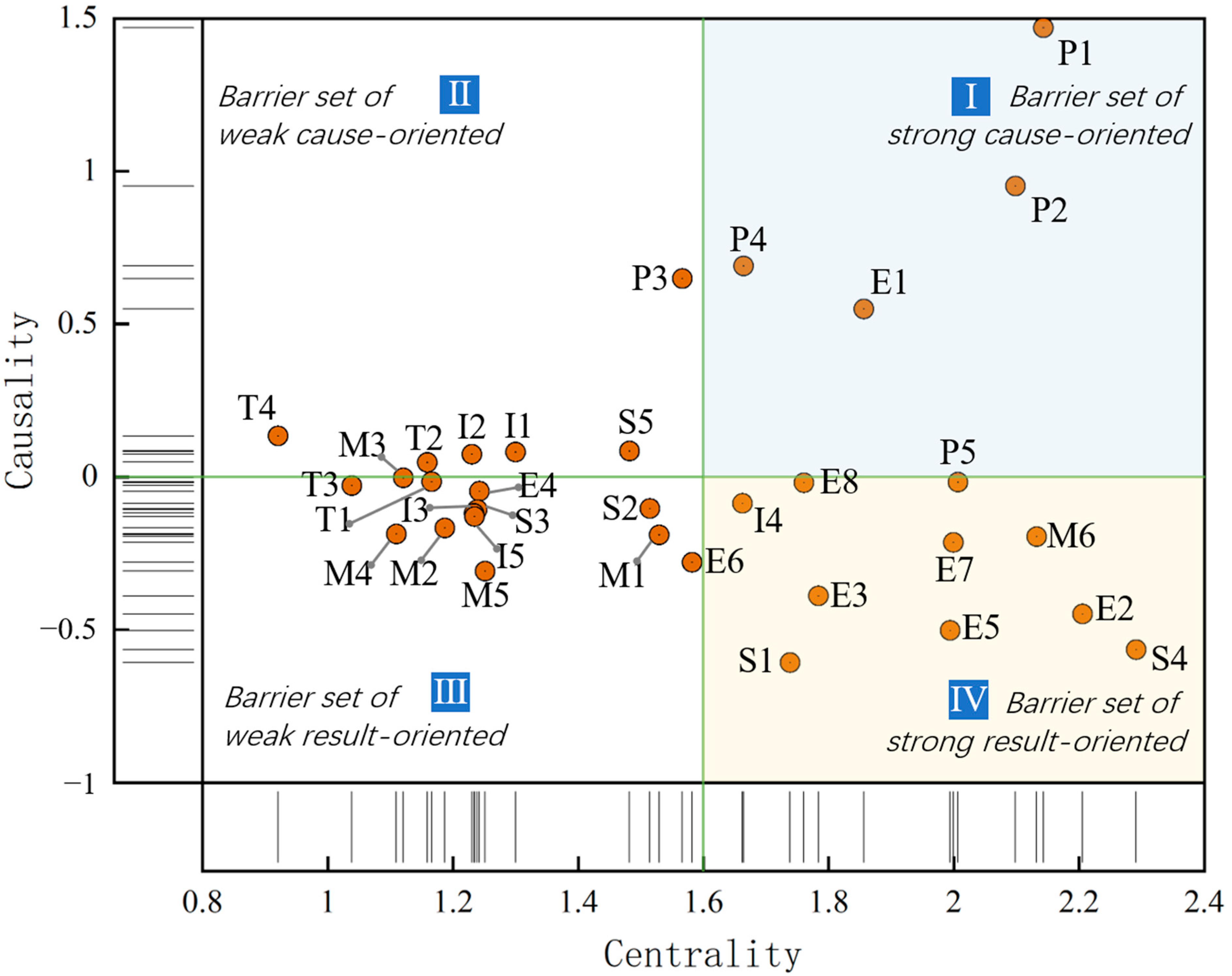
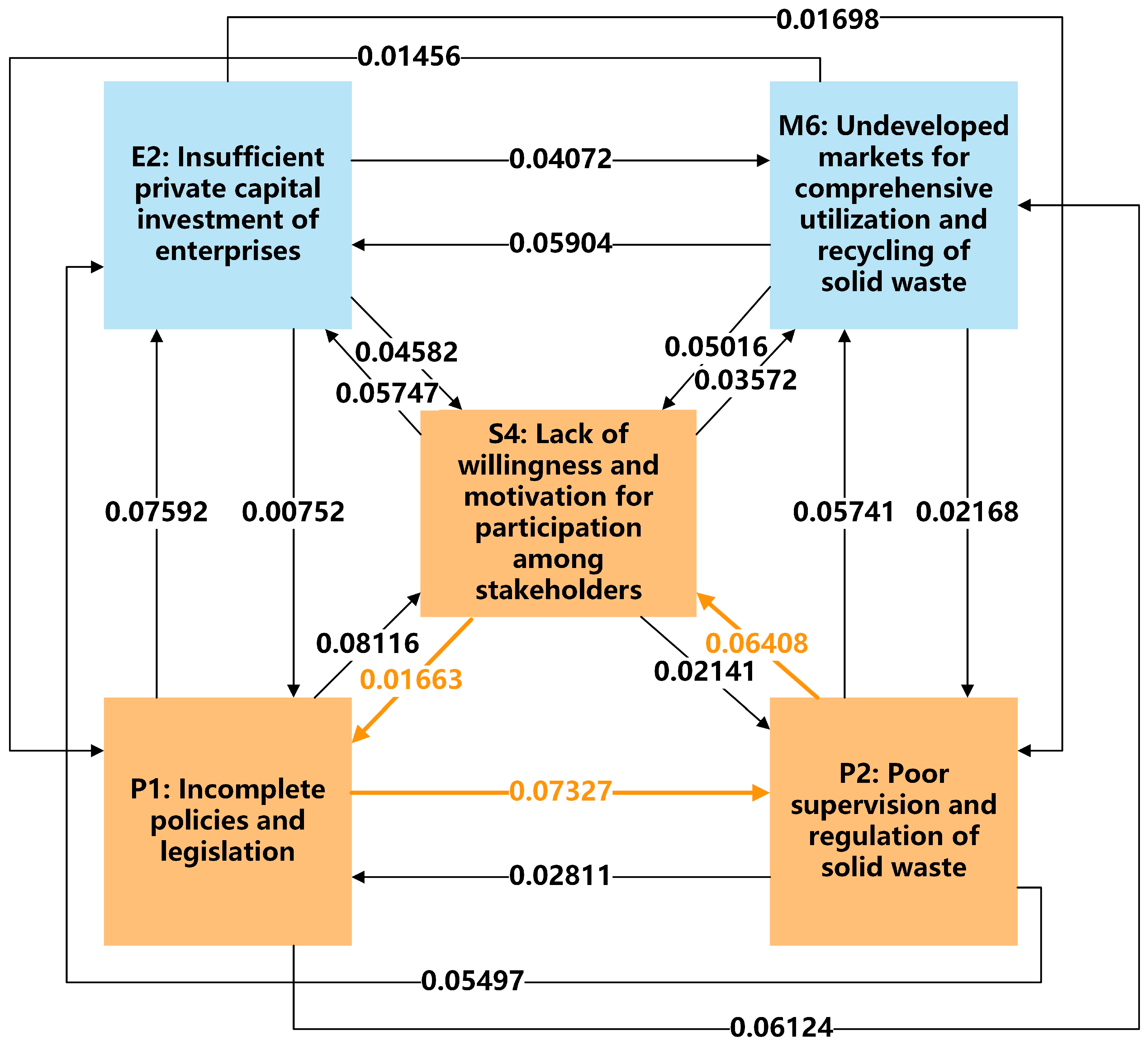
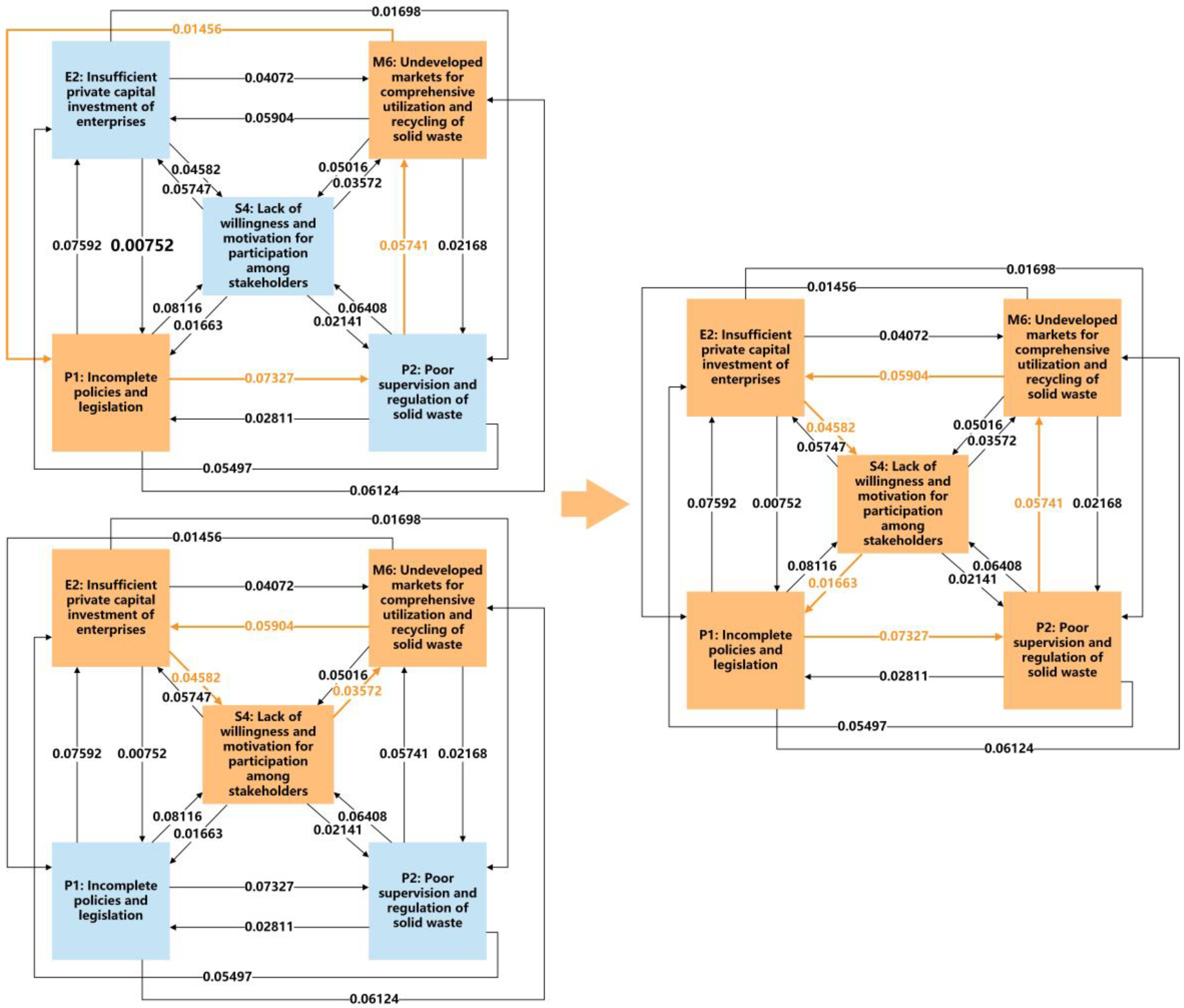
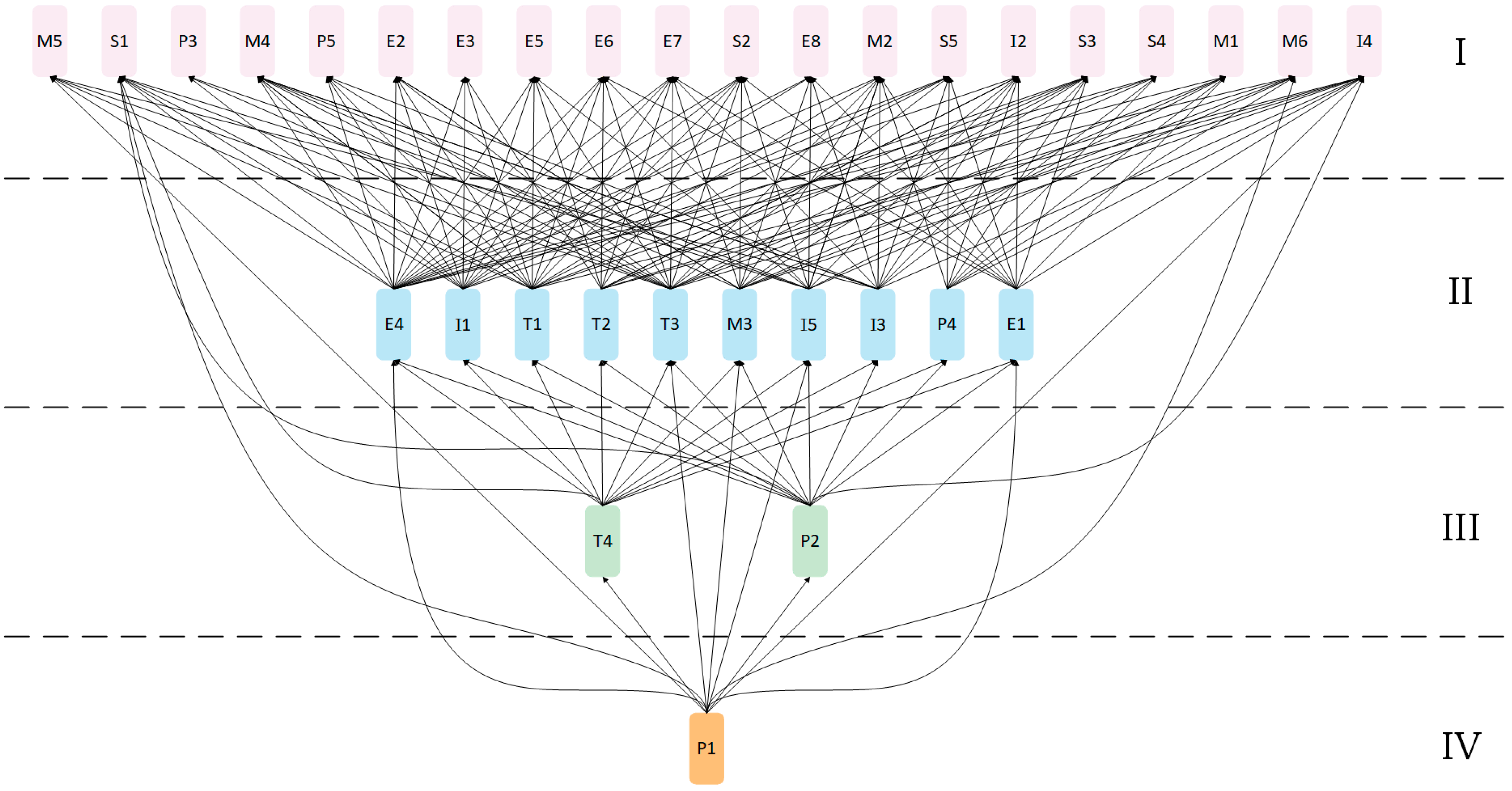
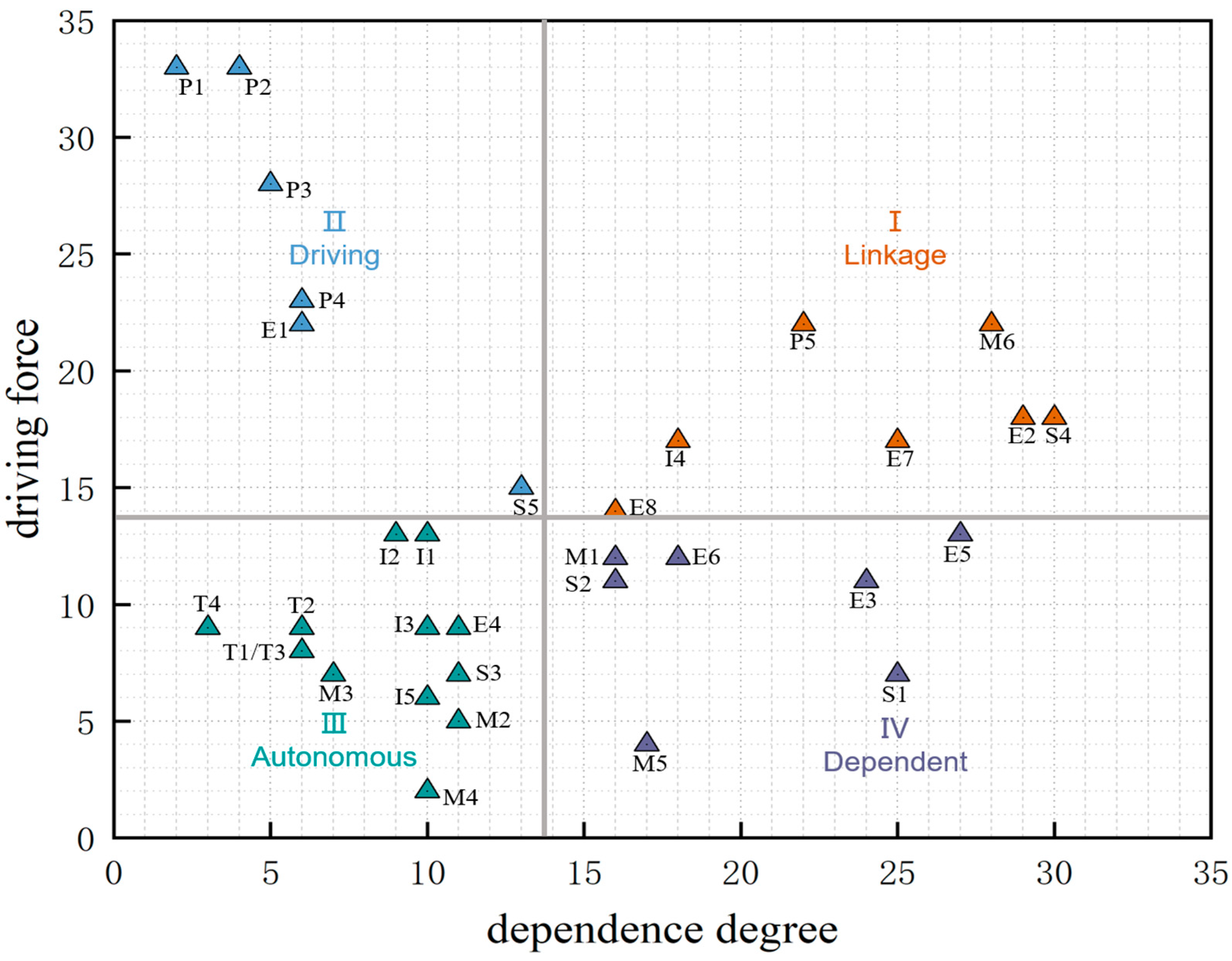
| Data Source | Original Materials | Open Coding | Axial Coding | Selective Coding | |
|---|---|---|---|---|---|
| Interview record | Interviewee 1 | Solid waste collection and transportation involves long-distance transportation and specialized treatment, which leads to high logistics costs, directly raising the production costs of USB and, to a certain extent, restricting the economic feasibility of resource utilization. | Solid waste is more costly to store and transport due to its unique characteristics and large size. | Extra cost of transportation and storage sites of solid waste. | Economy |
| Interviewee 2 | At present, there is too little publicity on using solid waste as building material in China. The public has limited knowledge of solid waste recycling channels, limited knowledge of using solid waste as building material, and insufficient understanding of the benefits and responsibilities of solid waste recycling. | Insufficient media publicity on solid waste building materials, and low public understanding of and trust in solid waste building materials. | Low consumer trust in green building materials. | Society | |
| Interviewee 3 | The management system for general industrial solid waste is still in the initial stage of development. From the source of generation, storage, and transportation to resource utilization, the whole life cycle management, is related to the environment sector’s regulatory responsibilities, the development and reform of industrial policy guidance, and industry standards in the industry and information technology sectors. Multi-departmental collaborative management is necessary, but at present, each department’s boundaries and division of powers and responsibilities is not clear enough, which to a certain extent, restricts the standardized development of general industrial solid waste in the field of building material utilization. | Incomplete policies and legislation. The solid waste management system does not yet have an established a set of systematic processes, and the division of authority and responsibility among multiple departments is not yet clear. | Poor supervision and regulation of solid waste. | Policy | |
| … … | |||||
| Literature | Investigating Barriers to Sustainable Management of Construction and Demolition Waste: the Case of India [61] | At present, the field of solid waste management is facing the problem of insufficient trained professional personnel. Specifically, this manifests as follows: practitioners generally lack systematic solid waste management knowledge training and professional skills training. This lack of professionalism not only increases the risk of errors in the operation process but also directly affects the overall efficiency of the utilization of solid waste building material. | Inexperience and inefficiency of some staff in the solid waste area. | Insufficient training of relevant personnel and limited skilled labor. | Management |
| Analysis of Factors Affecting the Circularity of Building Materials [34] | The current solid waste-based building material market still comprises low-quality construction materials with low recycling potential, and is based on low-cost technologies. | Current markets for integrated solid waste utilization and recycling are underdeveloped. | Undeveloped markets for comprehensive utilization and recycling of solid waste. | Management | |
| Exploring the restrictive factors for the development of the construction waste recycling industry in a second-tier Chinese city: a case study from Jinan [62] | There is a lack of mature technical specifications and quality standards for recycled products, and inadequate tracking of long-term performance of recycled products. | Currently, there is a lack of technical specifications and product quality standards for waste building materials. | Lack of technical and quality standards for USB. | Technology | |
| … … | |||||
| Policy | Guiding Opinions on Accelerating the Establishment of a Waste Recycling System | The main responsibility of waste recycling and technology paths should be clarified according to the characteristics of various types of waste, such as source, scale, resource value, utilization mode, ecological and environmental impact, etc. The resource recycling industry should be organized according to the local conditions, and the operation efficiency of the waste recycling system should be improved. | Solid waste has a complex composition with many classification criteria. It is difficult to clarify the composition, so it is not well classified and utilized. | Unclear composition of solid waste. | Technology |
| Guiding Opinions on Accelerating the Comprehensive Green Transition of Economic and Social Development | Vigorously promote the green and low-carbon transformation of iron and steel, non-ferrous metals, petrochemicals, chemicals, building materials, paper, printing, and dyeing industries; promote energy-saving, low-carbon, and cleaner production technology and equipment; promote the updating and upgrading of processes. | At present, solid waste recycling enterprises generally lack clean production mechanisms and sustainable development systems for the use of building materials, especially in the pre-treatment of raw materials, recycled aggregate processing, and other key aspects. This failure to establish standardized, low-carbon operating norms restricts the efficiency of the transformation of solid waste resources into high-quality building materials. | Unclear mechanisms to achieve cleaner production and sustainable development of enterprises. | Management | |
| … … | |||||
| Expert | Education | Experience | Affiliations | Professional Title |
|---|---|---|---|---|
| Expert 1 | PhD | 12 | Research institution | Professor |
| Expert 2 | PhD | 5 | Research institution | Research fellow |
| Expert 3 | PhD | 7 | Research institution | Associate research fellow |
| Expert 4 | PhD | 8 | Research institution | Associate research fellow |
| Expert 5 | PhD | 15 | University | Professor |
| Expert 6 | PhD | 12 | University | Professor |
| Expert 7 | PhD | 7 | University | Associate professor |
| Expert 8 | PhD | 8 | University | Associate professor |
| Expert 9 | PhD | 8 | Governmental agencies | Government executive |
| Expert 10 | Master | 11 | Governmental agencies | Public servant |
| Expert 11 | Master | 9 | Building material enterprise | Manager |
| Expert 12 | Master | 13 | Building material enterprise | Manager |
| Expert 13 | Master | 8 | Construction contractor | Project manager |
| Barriers | Influence Degrees | Influenced Degrees | Centrality | Ranking of Centrality | Causality | Ranking of Causality |
|---|---|---|---|---|---|---|
| P1 | 1.80677 | 0.33627 | 2.14304 | 3 | 1.4705 | 1 |
| P2 | 1.52518 | 0.57311 | 2.09829 | 5 | 0.95207 | 2 |
| P3 | 1.10789 | 0.45826 | 1.56615 | 16 | 0.64963 | 4 |
| P4 | 1.17716 | 0.4869 | 1.66406 | 13 | 0.69026 | 3 |
| P5 | 0.99452 | 1.01191 | 2.00643 | 6 | −0.01739 | 13 |
| E1 | 1.20276 | 0.65328 | 1.85604 | 9 | 0.54948 | 5 |
| E2 | 0.87827 | 1.32711 | 2.20538 | 2 | −0.44884 | 30 |
| E3 | 0.69695 | 1.08656 | 1.78351 | 10 | −0.38961 | 29 |
| E4 | 0.5978 | 0.64448 | 1.24228 | 22 | −0.04668 | 16 |
| E5 | 0.74565 | 1.24835 | 1.994 | 8 | −0.5027 | 31 |
| E6 | 0.65123 | 0.93076 | 1.58199 | 15 | −0.27953 | 27 |
| E7 | 0.8924 | 1.10677 | 1.99917 | 7 | −0.21437 | 26 |
| E8 | 0.8705 | 0.88994 | 1.76044 | 11 | −0.01944 | 14 |
| S1 | 0.56515 | 1.17311 | 1.73826 | 12 | −0.60796 | 33 |
| S2 | 0.70558 | 0.80891 | 1.51449 | 18 | −0.10333 | 18 |
| S3 | 0.56611 | 0.67276 | 1.23887 | 23 | −0.10665 | 19 |
| S4 | 0.86281 | 1.42826 | 2.29107 | 1 | −0.56545 | 32 |
| S5 | 0.78329 | 0.6986 | 1.48189 | 19 | 0.08469 | 7 |
| T1 | 0.57525 | 0.59079 | 1.16604 | 28 | −0.01554 | 12 |
| T2 | 0.60316 | 0.5558 | 1.15896 | 29 | 0.04736 | 10 |
| T3 | 0.50478 | 0.53353 | 1.03831 | 32 | −0.02875 | 15 |
| T4 | 0.52732 | 0.39335 | 0.92067 | 33 | 0.13397 | 6 |
| M1 | 0.66979 | 0.85944 | 1.52923 | 17 | −0.18965 | 24 |
| M2 | 0.5101 | 0.67693 | 1.18703 | 27 | −0.16683 | 22 |
| M3 | 0.55883 | 0.56191 | 1.12074 | 30 | −0.00308 | 11 |
| M4 | 0.46127 | 0.64826 | 1.10953 | 31 | −0.18699 | 23 |
| M5 | 0.47126 | 0.78005 | 1.25131 | 21 | −0.30879 | 28 |
| M6 | 0.96832 | 1.16396 | 2.13228 | 4 | −0.19564 | 25 |
| I1 | 0.69061 | 0.60936 | 1.29997 | 20 | 0.08125 | 8 |
| I2 | 0.6522 | 0.57803 | 1.23023 | 26 | 0.07417 | 9 |
| I3 | 0.55688 | 0.67689 | 1.23377 | 25 | −0.12001 | 20 |
| I4 | 0.78786 | 0.87464 | 1.6625 | 14 | −0.08678 | 17 |
| I5 | 0.55252 | 0.68189 | 1.23441 | 24 | −0.12937 | 21 |
| Barrier | P1 | P2 | E2 | S4 | M6 |
|---|---|---|---|---|---|
| P1 | 1.01089 | 0.07327 | 0.07592 | 0.08116 | 0.06124 |
| P2 | 0.02811 | 1.01534 | 0.05497 | 0.06408 | 0.05741 |
| E2 | 0.00752 | 0.01698 | 1.0207 | 0.04582 | 0.04072 |
| S4 | 0.01663 | 0.02141 | 0.05747 | 1.0221 | 0.03572 |
| M6 | 0.01456 | 0.02168 | 0.05904 | 0.05016 | 1.02016 |
| Barriers | Reachability Set | Antecedents Set | Intersection Set | Level |
|---|---|---|---|---|
| P1 | P1, P2, P3, P4, P5, E1, E2, E3, E4, E5, E6, E7, E8, S1, S2, S3, S4, S5, T1, T2, T3, T4, M1, M2, M3, M4, M5, M6, I1, I2, I3, I4, I5 | P1, P2 | P1, P2 | IV |
| P2 | P1, P2, P3, P4, P5, E1, E2, E3, E4, E5, E6, E7, E8, S1, S2, S3, S4, S5, T1, T2, T3, T4, M1, M2, M3, M4, M5, M6, I1, I2, I3, I4, I5 | P1, P2, P3, E1 | P1, P2, P3, E1 | III |
| P3 | P2, P3, P4, P5, E1, E2, E3, E4, E5, E6, E7, E8, S1, S2, S3, S4, S5, T1, M1, M2, M3, M4, M5, M6, I1, I2, I4, I5 | P1, P2, P3, S4, M1 | P2, P3, S4, M1 | I |
| P4 | P4, P5, E2, E3, E5, E7, E8, S1, S2, S3, S4, S5, T2, M1, M2, M3, M4, M5, M6, I1, I3, I4, I5 | P1, P2, P3, P4, E1, I4 | P4, I4 | II |
| P5 | P5, E2, E3, E5, E7, E8, S1, S2, S3, S4, S5, T1, M1, M2, M3, M4, M5, M6, I1, I3, I4, I5 | P1, P2, P3, P4, P5, P6, P7, E3, E5, E7, E8, S2, S4, S5, T1, T2, T3, M1, M3, M6, I2, I4 | P5, E1, E2, E5, E7, E8, S2, S4, S5, T1, M1, M3, M6, I4 | I |
| E1 | P2, P4, P5, E1, E2, E3, E4, E5, E6, E7, E8, S1, S2, S3, S4, S5, M1, M2, M4, M5, M6, I4 | P1, P2, P3, E1, M6, I4 | P2, E1, M6, I4 | II |
| E2 | P5, E2, E3, E4, E5, E6, E7, E8, S1, S2, S4, S5, T2, M1, M2, M5, M6, I4 | P1, P2, P3, P4, P5, E1, E2, E3, E4, E5, E6, E7, E8, S1, S2, S3, S4, S5, T1, T2, T3, M1, M3, M6, I1, I2, I3, I4, I5 | P5, E2, E3, E4, E5, E6, E7, E8, S1, S2, S4, S5, T2, M1, M6, I4 | I |
| E3 | P5, E2, E3, E4, E5, E6, E7, E8, S4, M5, M6 | P1, P2, P3, P4, P5, E1, E2, E3, E4, E5, E6, E7, E8, S1, S2, S4, S5, T4, M2, M6, I1, I2, I3, I4 | P5, E2, E3, E4, E5, E6, E7, E8, S4, M6 | I |
| E4 | E2, E3, E4, E5, E6, E7, E8, S4, M6 | P1, P2, P3, E1, E2, E3, E4, E6, E7, E8, T4 | E2, E3, E4, E6, E7, E8 | II |
| E5 | P5, E2, E3, E5, E6, E7, E8, S1, S4, M1, M5, M6, I4 | P1, P2, P3, P4, P5, E1, E2, E3, E4, E5, E6, E7, E8, S1, S2, S4, S5, T3, T4, M1, M2, M5, M6, I1, I2, I3, I4 | P5, E2, E3, E5, E6, E7, E8, S1, S4, M1, M5, M6, I4 | I |
| E6 | E2, E3, E4, E5, E6, E7, S4, M5, M6, I1, I2, I3 | P1, P2, P3, E1, E2, E3, E4, E5, E6, E7, E8, S4, S5, T1, M6, I1, I3, I4 | E2, E3, E4, E5, E6, E7, S4, M6, I1, I3 | I |
| E7 | P5, E2, E3, E4, E5, E6, E7, E8, S1, S2, S4, T2, T3, M1, M4, M5, M6 | P1, P2, P3, P4, P5, E1, E2, E3, E4, E5, E6, E7, E8, S4, S5, T1, T2, T3, T4, M1, M3, M5, M6, I2, I4 | P5, E2, E3, E4, E5, E6, E7, E8, S4, T2, T3, M1, M5, M6 | I |
| E8 | P5, E2, E3, E4, E5, E6, E7, E8, S1, S2, S4, T3, M1, M6 | P1, P2, P3, P4, P5, E1, E2, E3, E4, E5, E7, E8, S4, S5, M6, I4 | P5, E2, E3, E4, E5, E7, E8, S4, M6 | I |
| S1 | E2, E3, E5, S1, S3, S4, M6 | P1, P2, P3, P4, P5, E1, E2, E5, E7, E8, S1, S2, S3, S4, S5, T1, T3, T4, M1, M3, M6, I1, I2, I3, I4 | E2, E5, S1, S3, S4, M6 | I |
| S2 | P5, E2, E3, E5, S1, S2, S3, S4, S5, M6, I4 | P1, P2, P3, P4, P5, E1, E2, E7, E8, S2, S3, S4, S5, M6, I1, I4 | P5, E2, S2, S3, S4, S5, M6, I4 | I |
| S3 | E2, S1, S2, S3, S4, S5, M6 | P1, P2, P3, P4, P5, E1, S1, S2, S3, S4, I4 | S1, S2, S3, S4 | I |
| S4 | P3, P5, E2, E3, E5, E6, E7, E8, S1, S2, S3, S4, S5, M1, M2, M6, I2, I4 | P1, P2, P3, P4, P5, E1, E2, E3, E4, E5, E6, E7, E8, S1, S2, S3, S4, S5, T1, T3, T4, M1, M2, M3, M6, I1, I2, I3, I4, I5 | P3, P5, E2, E3, E5, E6, E7, E8, S1, S2, S3, S4, S5, M1, M2, M6, I2, I4 | I |
| S5 | P5, E2, E3, E5, E6, E7, E8, S1, S2, S4, S5, M1, M5, M6, I4 | P1, P2, P3, P4, P5, E1, S2, S3, S4, S5, M6, I4 | P5, E2, S2, S4, S5, M6, I4 | I |
| T1 | P5, E2, E6, E7, S1, S4, T1, M6 | P1, P2, P3, P5, T1, T4 | P5, T1 | II |
| T2 | P5, E2, E7, T2, I1, I2, I3, I4, I5 | P1, P2, P4, E2, E7, T2 | E2, E7, T2 | II |
| T3 | P5, E2, E5, E7, S1, S4, T3, M6 | P1, P2, E7, E8, T3, T4 | E7, T3 | II |
| T4 | E3, E4, E5, E7, S1, S4, T1, T3, T4 | P1, P2, T4 | T4 | III |
| M1 | P3, P5, E2, E5, E7, S1, S4, M1, M2, M4, M5, M6 | P1, P2, P3, P4, P5, E1, E2, E5, E7, E8, S4, S5, M1, M2, M6, I4 | P3, P5, E2, E5, E7, S4, M1, M2, M6 | I |
| M2 | E3, E5, S4, M1, M2 | P1, P2, P3, P4, P5, E1, E2, S4, M1, M2, M6 | S4, M1, M2 | I |
| M3 | P5, E2, E7, S1, S4, M3, M6 | P1, P2, P3, P4, P5, M3, M6 | P5, M3, M6 | II |
| M4 | M4, M5 | P1, P2, P3, P4, P5, E1, E7, M1, M4, M5 | M4, M5 | I |
| M5 | E5, E7, M4, M5 | P1, P2, P3, P4, P5, E1, E2, E3, E5, E6, E7, S5, M1, M4, M5, M6, I5 | E5, E7, M4, M5 | I |
| M6 | P5, E1, E2, E3, E5, E6, E7, E8, S1, S2, S4, S5, M1, M2, M3, M5, M6, I1, I2, I3, I4, I5 | P1, P2, P3, P4, P5, E1, E2, E3, E4, E5, E6, E7, E8, S1, S2, S3, S4, S5, T1, T3, M1, M3, M6, I1, I2, I3, I4, I5 | P5, E1, E2, E3, E5, E6, E7, E8, S1, S2, S4, S5, M1, M3, M6, I1, I2, I3, I4, I5 | I |
| I1 | E2, E3, E5, E6, S1, S2, S4, M6, I1, I2, I3, I4, I5 | P1, P2, P3, P4, P5, E6, T2, M6, I1, I2 | E6, M6, I1, I2 | II |
| I2 | P5, E2, E3, E5, E7, S1, S4, M6, I1, I2, I3, I4, I5 | P1, P2, P3, E6, S4, T2, M6, I1, I2 | S4, M6, I1, I2 | I |
| I3 | E2, E3, E5, E6, S1, S4, M6, I3, I4 | P1, P2, P4, P5, E6, T2, M6, I1, I2, I3 | E6, M6, I3 | II |
| I4 | P4, P5, E1, E2, E3, E5, E6, E7, E8, S1, S2, S3, S4, S5, M1, M6, I4 | P1, P2, P3, P4, P5, E1, E2, E5, S2, S4, S5, T2, M6, I1, I2, I3, I4, I5 | P4, P5, E1, E2, E5, S2, S4, S5, M6, I4 | I |
| I5 | E2, S4, M5, M6, I4, I5 | P1, P2, P3, P4, P5, T2, M6, I1, I2, I5 | M6, I5 | II |
Disclaimer/Publisher’s Note: The statements, opinions and data contained in all publications are solely those of the individual author(s) and contributor(s) and not of MDPI and/or the editor(s). MDPI and/or the editor(s) disclaim responsibility for any injury to people or property resulting from any ideas, methods, instructions or products referred to in the content. |
© 2025 by the authors. Licensee MDPI, Basel, Switzerland. This article is an open access article distributed under the terms and conditions of the Creative Commons Attribution (CC BY) license (https://creativecommons.org/licenses/by/4.0/).
Share and Cite
Zhou, S.; Cai, L.; Xie, D.; Xia, Y.; Chang, M. Evaluating Critical Barriers to Utilization of Solid Waste as Building Material (USB) in China: An Integrated DEMATEL Approach. Buildings 2025, 15, 3679. https://doi.org/10.3390/buildings15203679
Zhou S, Cai L, Xie D, Xia Y, Chang M. Evaluating Critical Barriers to Utilization of Solid Waste as Building Material (USB) in China: An Integrated DEMATEL Approach. Buildings. 2025; 15(20):3679. https://doi.org/10.3390/buildings15203679
Chicago/Turabian StyleZhou, Sujuan, Lixiong Cai, Dingkun Xie, Yaohui Xia, and Mingjing Chang. 2025. "Evaluating Critical Barriers to Utilization of Solid Waste as Building Material (USB) in China: An Integrated DEMATEL Approach" Buildings 15, no. 20: 3679. https://doi.org/10.3390/buildings15203679
APA StyleZhou, S., Cai, L., Xie, D., Xia, Y., & Chang, M. (2025). Evaluating Critical Barriers to Utilization of Solid Waste as Building Material (USB) in China: An Integrated DEMATEL Approach. Buildings, 15(20), 3679. https://doi.org/10.3390/buildings15203679






